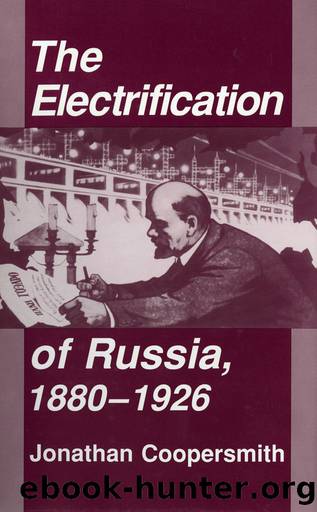The Electrification of Russia, 1880â1926 by Jonathan Coopersmith

Author:Jonathan Coopersmith [Coopersmith, Jonathan]
Language: eng
Format: epub
Tags: General, Russia & the Former Soviet Union, Technology & Engineering, Electrical, Europe, History
ISBN: 9781501705366
Google: RaasDgAAQBAJ
Publisher: Cornell
Published: 2016-11-01T13:54:43+00:00
Electrification had a growing base of support in the government. The numerous wartime commissions and other bodies established to regulate fuel and power played an important role in institutionalizing electrical engineers into the leadership circles of the country. This infusion of electrical engineers into government positions did not take firm root until the February revolution but expanded rapidly after the October revolution. The âMoscow mafiaâ based at the 1886 Company created and filled new state positions, while the heat committee provided important theoretical and factual underpinnings for electrification planning and contributed to immediate utility survival.
Until surpassed in the 1920S by Gosplan, the heat committee dominated regional electrification planning.105 Its members wrote on electrification, developed the city-saving Makarev boiler, and worked in government bureaus.106 The committeeâs most prominent members, Kirsh, Grinevetskii, Krug, and Leonid K. Ramzin, never equaled the 1886 Companyâs âMoscow mafiaâ in importance for reasons of politics, death, and institutional weakness. The committeeâs members tended to the more moderate Menshevik and Cadet political factions, which restricted any possibility of leadership under Bolshevik rule. The deaths of Kirsh and Grinevetskii in the 1919 typhus epidemic eliminated two leaders.107 Finally, these men worked in an academic environment and did not participate directly in utility and government operations. Ultimately, these professors could advise but not lead.
The transfer of the capital to Moscow in 1918 and the ascendence of the practicing over the university engineer reduced the importance of the Petrograd electrotechnical leadership. Osadchii is an excellent example of the transfer of leadership. Before October 1917, he headed the VI Section, the new Union of Electrotechnicians, and the SED. After October, he worked for the Petrograd branches of the TsES and later GOELRO. In 1921, he moved to Moscow to work for Gosplan, the state planning agency, and the science and technical section of the VSNKh. The shift to Moscow of the electrical engineering leadership symbolized its eagerness to establish closer ties with the new government and the stateâs recognition of the necessity of electric power for industrial society. Neither electrical engineers nor government could prosper without the other. In contrast, the Academy of Sciences resisted Bolshevik rule and did not move physically to Moscow until 1934 as part of a state centralization of the management of science following a reorganization that reduced the academyâs independence.108
One striking aspect of Soviet rule was the multiple posts held by engineer-managers, a reflection of the hodgepodge of new organizations, shortages of skilled people, and the extraordinary outburst of technocratic enthusiasm. Krzhizhanovskii, the premier example, in 1919 had executive responsibilities in the KGS, Elektroperedacha, the ETO, the Extraordinary Commission for Electricity Supply in Moscow, the operating board of the Bogorod electric stations, and the board of the state wire and cables factories as well as serving as a delegate to the Moscow Soviet. Krasin and Boris Kushner, a Bolshevik journalist, formed two-thirds of both the ETO governing board and the Extraordinary Commission for Managing the Unified Electro-technical Industry.109 Krasin also was a TsES member, served on the VSNKh presidium, chaired the Special Commission to Supply the Red Army, and worked on foreign trade.
Download
This site does not store any files on its server. We only index and link to content provided by other sites. Please contact the content providers to delete copyright contents if any and email us, we'll remove relevant links or contents immediately.
| Circuits | Digital Design |
| Electric Machinery & Motors | Electronics |
| Fiber Optics | Networks |
| Superconductivity |
Whiskies Galore by Ian Buxton(41881)
Introduction to Aircraft Design (Cambridge Aerospace Series) by John P. Fielding(33064)
Small Unmanned Fixed-wing Aircraft Design by Andrew J. Keane Andras Sobester James P. Scanlan & András Sóbester & James P. Scanlan(32743)
Craft Beer for the Homebrewer by Michael Agnew(18142)
Turbulence by E. J. Noyes(7937)
The Complete Stick Figure Physics Tutorials by Allen Sarah(7309)
Kaplan MCAT General Chemistry Review by Kaplan(6867)
The Thirst by Nesbo Jo(6829)
Bad Blood by John Carreyrou(6552)
Modelling of Convective Heat and Mass Transfer in Rotating Flows by Igor V. Shevchuk(6391)
Learning SQL by Alan Beaulieu(6211)
Weapons of Math Destruction by Cathy O'Neil(6147)
Man-made Catastrophes and Risk Information Concealment by Dmitry Chernov & Didier Sornette(5922)
Digital Minimalism by Cal Newport;(5664)
Life 3.0: Being Human in the Age of Artificial Intelligence by Tegmark Max(5474)
iGen by Jean M. Twenge(5366)
Secrets of Antigravity Propulsion: Tesla, UFOs, and Classified Aerospace Technology by Ph.D. Paul A. Laviolette(5309)
Design of Trajectory Optimization Approach for Space Maneuver Vehicle Skip Entry Problems by Runqi Chai & Al Savvaris & Antonios Tsourdos & Senchun Chai(5011)
Pale Blue Dot by Carl Sagan(4913)
